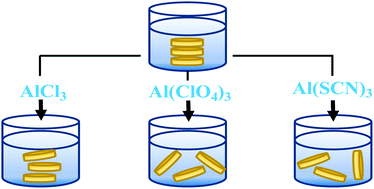The chaotropic effect of ions on the self-aggregating propensity of Whitlock's molecular tweezers†
Abstract
Molecular tweezers feature the first class of artificial receptors to pique the interest of researchers and emerge as an effective therapeutic candidate. The exceptional structure and exquisite binding specificity of tweezers establish this overall class of receptors as a promising tool, with abundant applications. However, their inclination to self-aggregate by mutual π–π stacking interactions of their aromatic arms diminishes their efficacy as a therapeutic candidate. Therefore, following up on sporadic studies, since the discovery of the Hofmeister series, on the ability of ions to either solvate (salting-in) or induce aggregation (salting-out) of hydrophobic solutes, the notions of ion-specificity effects are utilized on tweezer moieties. The impacts of three different aluminum salts bearing anions Cl−, ClO4− and SCN− on the self-association propensity of Whitlock's caffeine-pincered molecular tweezers are investigated, with a specific emphasis placed on elucidating the varied behavior of the ions on the hydration ability of tweezers. The comparative investigation is conducted employing a series of all-atom molecular dynamics simulations of five tweezer molecules in pure water and three salt solutions, at two different concentrations each, maintaining a temperature of 300 K and a pressure of 1 atm, respectively. Radial distribution functions, coordination numbers, and SASA calculations display a steady reduction in the aggregation proclivity of the receptor molecules with an increase in salt concentration, as progressed along the Hofmeister series. Orientational preferences between the tweezer arms reveal a disruptive effect in the regular π–π stacking interactions, in the presence of high concentrations of ClO4− and SCN− ions, while preferential interactions and tetrahedral order parameters unveil the underlying mechanism, by which the anions alter the solubility of the hydrophobic molecules. Overall, it is observed that SCN− exhibits the highest salting-in effect, followed by ClO4−, with both anions inhibiting tweezer aggregation through different mechanisms. ClO4− ions impart an effect by moderately interacting with the solute molecules as well as modifying the water structure of the bulk solution promoting solvation, whereas, SCN− ions engage entirely in interaction with specific tweezer sites. Cl− being the most charge-dense of the three anionic species experiences stronger hydration and therefore, imparts a very negligible salting-in effect.



 Please wait while we load your content...
Please wait while we load your content...